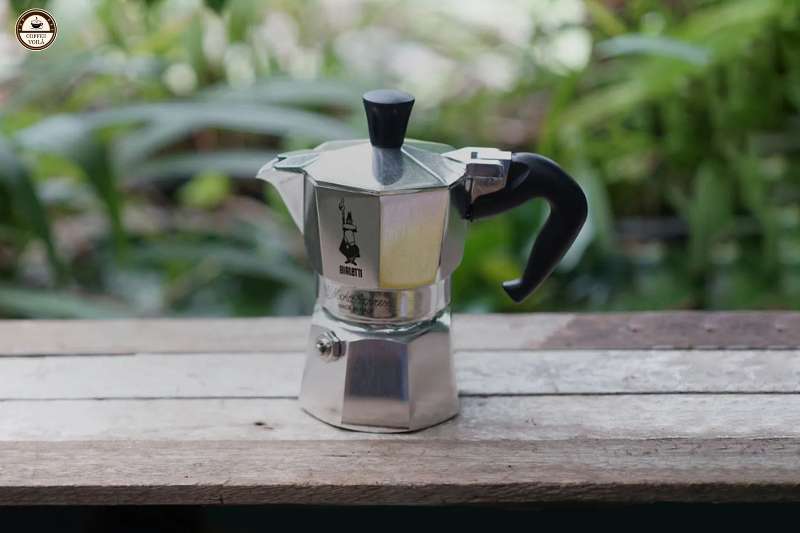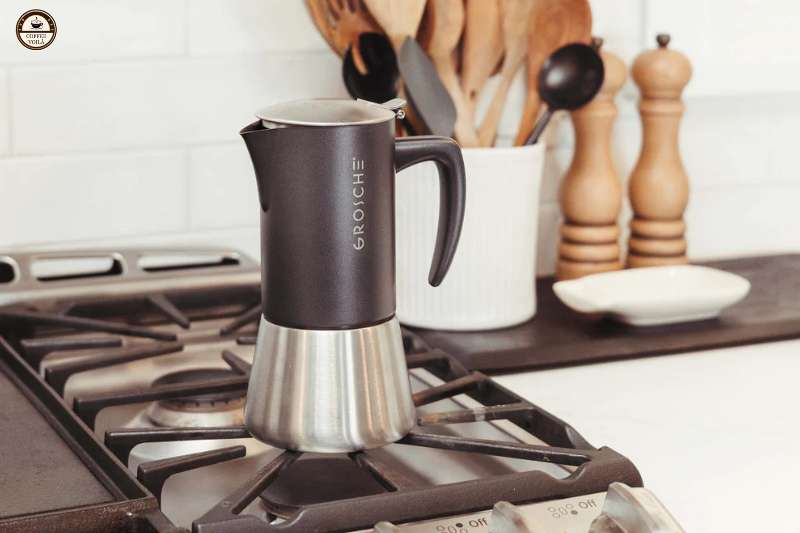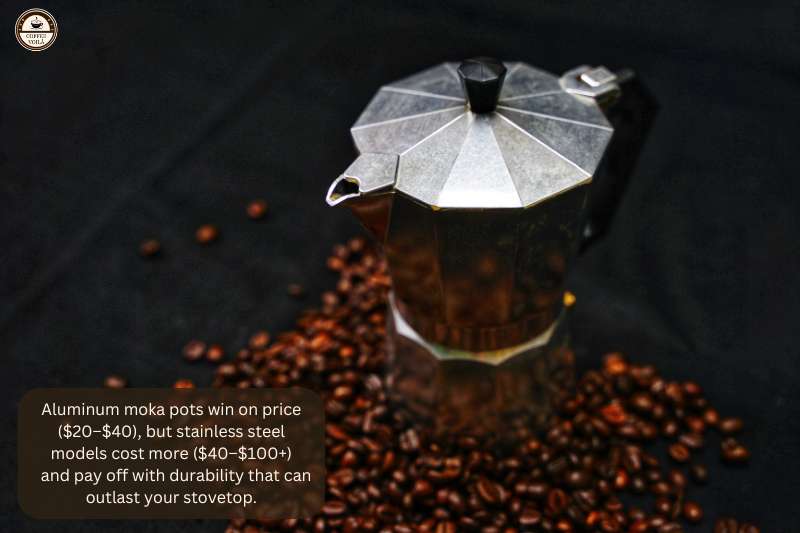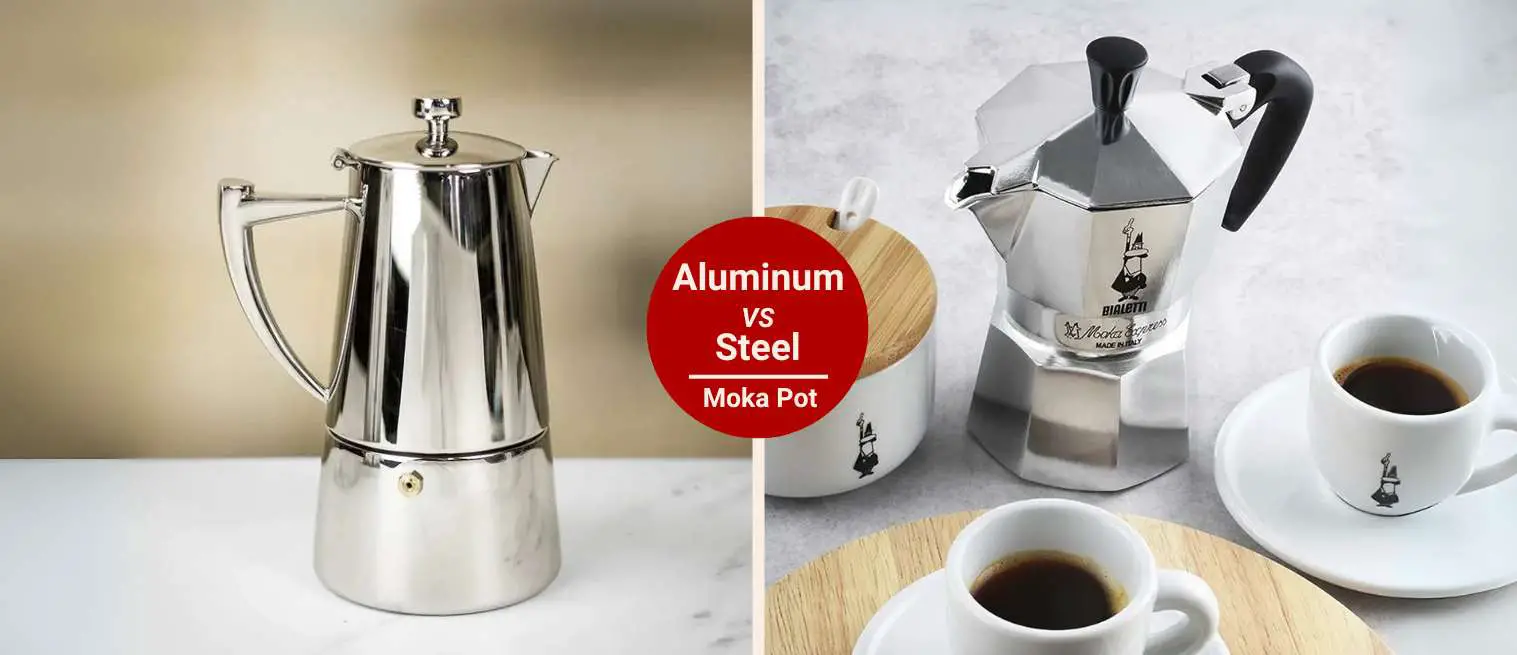Aluminum vs Stainless Steel Moka Pots: Which One Should You Buy?
Ever found yourself staring at a shelf full of moka pots, wondering which one to grab?
A few years ago, I was standing in the supermarket, completely stuck between an aluminum moka pot and a shiny stainless steel moka pot.
The aluminum one was cheaper and lighter, while the stainless looked tougher, like it would last forever. I must’ve picked each up three times, trying to figure out what really mattered: taste, price, or durability.
Honestly, I ended up walking out without buying anything that day because I couldn’t decide.
The problem is real: aluminum vs stainless moka pot isn’t just about looks. It changes how your coffee tastes, how long your pot lasts, and even how easy it is to clean.
In this guide, you’ll discover the pros and cons of each type, share some of the most popular models, and give you tips to help match the right moka pot to your lifestyle. So let’s start brewing!
Key takeaways
- Aluminum moka pots (like the Bialetti Moka Express) are lightweight, affordable, and brew coffee with a seasoned, slightly richer taste—but require hand-washing and more care.
- Stainless steel moka pots (like the Grosche Milano Steel or Cuisinox Roma) are durable, dishwasher-safe, and provide a cleaner flavor, though they’re heavier and more expensive.
- Price matters: aluminum usually costs $20–$40, while stainless steel runs $40–$100+. Stainless steel lasts longer, but aluminum is more budget-friendly.
- Choose based on your lifestyle: aluminum is great for travel and camping; stainless steel is best if you want long-term durability and easy cleaning.
Aluminum vs Stainless Steel Moka Pots (Quick Overview)
When you’re standing in front of the shelf (or scrolling online), it can feel like a toss-up between aluminum and stainless steel moka pots.
On the surface, they look similar. However, the material makes a huge difference in how they brew, how long they last, and even how your coffee tastes. For instance:
Aluminum Moka Pots
Aluminum moka pots are the classics. The ones you’ve probably seen in Italian kitchens for decades. They’re lightweight, heat up quickly, and they’ve got that iconic octagonal look (the Bialetti Moka Express is the gold standard here).

Furthermore, they’re budget-friendly, which makes them great for beginners.
Now the downside: Well, aluminum stains and discolors over time, and you have to hand-wash them. That said, some coffee lovers argue that the “seasoning” from coffee oils actually makes the flavor richer.
Stainless Steel Moka Pots
Stainless steel moka pots, like the Cuisinox Roma or Grosche Milano Steel, are built like tanks. They’re heavier, but also nearly indestructible.

Also, you don’t need to worry about dents or corrosion. These pots are dishwasher-safe (a big win if you hate hand-washing), and they don’t absorb flavors. For this reason, every cup tastes clean and consistent. The trade-off is that they cost more and take longer to heat up than aluminum.
Aluminum Moka Pots: Pros & Cons
If you’ve ever had a stovetop espresso in Italy, chances are it came out of an aluminum moka pot. The fact is, they’re the originals. The ones that gave moka pots their iconic look and flavor. But like anything in life, they have their pros and cons:
| Pros | Cons |
|---|---|
| Lightweight and easy to handle | Scratches and stains easily |
| Heats up quickly for faster brewing | Discolors over time (“patina” look) |
| Affordable ($20–$40) and budget-friendly | Must be hand-washed (not dishwasher safe) |
| Brews with a seasoned, richer flavor over time | Less durable compared to stainless steel |
| Iconic Italian design (e.g., Bialetti Moka Express) | Can warp or dent if dropped |
The biggest win for aluminum moka pots is how quickly they heat up. I’ve used mine on everything from a tiny gas burner at home to a camping stove in the woods, and it always gets the job done fast.
But here’s the catch: aluminum scratches, stains, and “seasons” with use. Some people love that patina. It gives the coffee a nutty, fuller flavor over time. Others hate the way it looks worn after only a few months.
Popular Examples
- Bialetti Moka Express – The absolute classic, still made in Italy, and probably the most recognizable moka pot in the world.
- Alessi Pulcina – A sleek, designer version that blends Italian style with aluminum tradition.
- Pedrini Moka Pot – A more budget-friendly option, also Italian-made, that still delivers a solid brew.
Stainless Steel Moka Pots: Pros & Cons
If aluminum moka pots are the rustic old-school option, stainless steel is sleeker and tougher. These pots are built to last, and if you’ve ever dented or discolored an aluminum pot, you’ll immediately see why people switch to steel. But as with anything, there are trade-offs you’ll want to weigh.
| Pros | Cons |
|---|---|
| Extremely durable and resistant to dents | More expensive ($40–$100+) |
| Dishwasher safe for easy cleaning | Heavier than aluminum pots |
| Maintains a clean, neutral flavor (no oil absorption) | Takes longer to heat up |
| Sleek, modern designs (e.g., Grosche Milano Steel, Bialetti Venus) | Less ideal for backpacking or ultralight travel |
| Long-lasting investment that outlives aluminum pots | Higher upfront cost compared to budget options |
The biggest draw here is durability. I’ve had stainless steel moka pots that looked brand new after years of use.
Meanwhile, my aluminum Bialetti showed scratches and stains after a few months. Also, they give you a clean, neutral flavor since they don’t absorb coffee oils the way aluminum does.
However, they’re heavier build makes them less suitable for backpacking or travel.
Popular Examples
- Grosche Milano Steel – A popular option that balances modern design with reliable brewing.
- Cuisinox Roma – A polished, premium stainless steel moka pot that feels like it could outlast your stove.
- Bialetti Venus – Bialetti’s stainless steel answer to the Moka Express, ideal if you love the brand but want a tougher build.
Aluminum vs Stainless Steel Moka Pot: Price Comparison
Both aluminum and stainless steel have their perks, but your wallet is probably going to nudge you one way or the other.

Aluminum Mora Pots
Usually, the budget-friendly pick. You’ll find classics like the Bialetti Moka Express or a Pedrini sitting in the $20–$40 range. That’s not bad at all for something that can last years if you treat it right.
I remember picking up my first aluminum Bialetti for about thirty bucks, and at the time it felt like a steal compared to my fancy espresso machine.
Stainless Steel
Models like the Cuisinox Roma, Grosche Milano Steel, or Bialetti Venus typically sit between $40 and $100+. That’s a jump, no doubt.
But here’s the thing, you’re paying for durability. I’ve dropped an aluminum pot before and watched it dent instantly. Meanwhile my stainless steel one shrugged off the fall like it never happened. Over the long run, that extra cash can pay off because you won’t need to replace it nearly as often.
Notes: if you want something budget-friendly, aluminum wins. If you’re thinking long-term investment and don’t mind spending a little more, stainless steel will probably outlast your stovetop.
Last Thoughts: Which One Should You Choose?
So, what matters most to you: budget, durability, or taste? Have you had experience with both aluminum and stainless steel moka pots? Which one do you swear by? Share your thoughts in the comments below, and help others make their choice too. And just like that, voilà!







